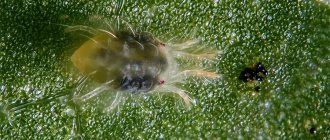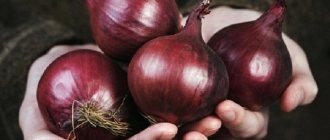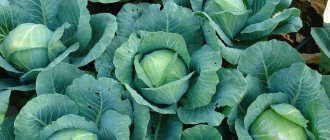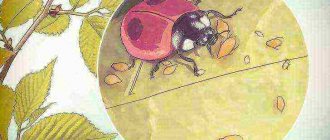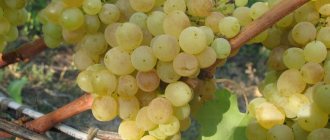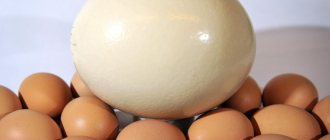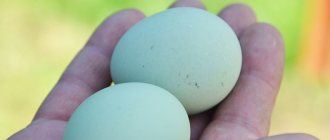Miracle cherry is one of the highest quality hybrids of cherries and cherries. Such shapes are called dukes. The development of this duke was carried out by scientists from the Donetsk Horticulture Research Station. It was possible to breed Duke through the selection of the Griot Ostgeimsky cherry and the Valery Chkalov cherry. The creators of the variety are L.I. Taranenko, A.I. Sychov.
In today’s publication we will present a description of the variety, show photos of the berries and talk about which pollinators are ideal for this hybrid.
Description of the variety
In terms of its characteristics and growth vigor, the hybrid is more reminiscent of a cherry, but in terms of the type of branching it is more reminiscent of a sweet cherry.
The leaf blades of the Miracle Cherry are large, their structure more reminiscent of cherry leaves. But in terms of density, they are more similar to cherry ones.
The stems are straight and quite powerful. They are protected by dark brown bark. The buds are very plump and quite large. In appearance they are more reminiscent of sweet cherry than cherry.
The top of the tree is branched, very much reminiscent of the crown of a cherry tree.
The hybrid begins to produce crops very early. Flower buds are formed during the annual growth.
This Duke managed to retain all the best characteristics of its ancestors. In particular, Miracle Cherry tolerates low temperatures well, which allows it to be grown in regions that are quite unfavorable for most varieties.
In addition, Miracle Cherry has a fairly strong immune system, which protects it from fungal diseases such as monilliosis and coccomycosis.
Miracle cherry
The history of growing dukes goes back several centuries. The name comes from the English hybrid of May Duck, bred in the 17th century. The first domestic Duke was received by I.V. Michurin in 1888, was distinguished by frost resistance, but had low yield. The Miracle variety was obtained in 1980 by L.I. Taranenko and A.I. Sychev by crossing Griot cherries and cherries Valery Chkalov.
Cherry-cherry hybrids resemble cherries in the shape of the crown and the quality of the fruit. And in terms of branching and leaf size, it resembles a cherry, but overall it is still closer to a cherry.
Advantages and disadvantages of the variety
This hybrid has a number of advantages, thanks to which many gardeners who encountered it liked it:
- The tree begins to bear fruit very early and produces a fairly good harvest.
- It has high frost resistance.
- Resistant to diseases such as monilliosis and coccomycosis, which are a real threat to cherry trees.
- The berries are very tasty and exude a pleasant aroma.
At the same time, we should not forget about the shortcomings of the Miracle Cherry. There are not so many of them, but still:
- This is not a self-fertile variety. This is a significant drawback, since an additional pollinator must be planted next to the duke.
- The tree grows very strongly, which requires constant formation of the crown.
Reviews Miracle cherry
I want to show off the harvest from the miracle cherry.
The variety of this cherry is early, that is, at the end of June you can harvest a good harvest. The berries of this cherry have a juicy sour taste. I don’t use it for jam, nor for making compote. I like to freeze these cherries for the winter and enjoy the fruits, remembering the summer. The fruits are dark red in color and also have a wonderful dessert taste. The seedlings of this tree are resistant to frost and drought, which makes their owners even more happy. The fruits of this variety are not eaten by worms; I literally found two or three of them. Time of use - 5 years. Year of purchase: 2012. General impression: the name of this cherry corresponds to reality. Gisa
I planted a miracle cherry a year ago.
It is growing, there were no fruits yet, I tried it from a friend. I liked it very much. This is duk - a hybrid of cherries and cherries, it is not sour. Children don't eat regular food, although I like it. And I think they will eat the Miracle Cherry. Lud-Mila
Hybrid Miracle has gained recognition among gardeners due to the dessert taste of the berries, the ability to not freeze in winter and resistance to disease. These beautiful trees are also used as an ornamental crop to decorate areas: no one will be indifferent to the magnificent view of cherry blossoms strewn with large fragrant flowers.
Planting a seedling
Before planting seedlings, the area is marked (if several trees are planted). It is necessary to take into account the fact that the distance between mature trees should be at least 4-5 meters. Between rows at least 5 meters. When the area is marked, they begin to prepare the holes. A hole is dug 80x80 cm. The depth is usually from 40 to 50 cm. If the soil is not very fertile, then a hole is dug about 70 cm deep and filled with fertilizer.
We recommend reading: Black-rind Cherry
A few days before planting, it is recommended to keep the seedlings in water with the addition of special growth stimulants (Zircon and the like). You can also treat the root system with a solution of potassium permanganate or potassium humate in order to protect the plant from possible fungal diseases. But this procedure is carried out only when the seedling has a weak root system.
The process of planting a future tree is as follows:
- Prepare the pit. Standardly it is 50 cm deep, but here you need to start from the conditions. If the soil is not nutritious, then the hole is made larger. The same applies to the root system. The larger it is, the deeper and wider the hole is made.
- Make a fertilized mixture. To do this, mix 2 or 3 buckets of humus, 1 kg of wood ash, 100 grams of superphosphate and 80 grams of potassium sulfate. This whole mixture goes into one well.
- The bottom of the pit is loosened by 10 cm and a bucket of water is poured out. The water should be warm, outside temperature.
- After the water is absorbed, the nutrient substrate that was prepared earlier is added to the hole. The hole is filled approximately 2/3. The soil is compacted.
- A peg is driven into the center, which will serve as a future support for our seedling. The diameter of the peg is about 5 cm, and its height is up to 1.5 m. This should be done before planting the seedling, and not after, so as not to damage its root system. Then the peg is covered with earth, creating a so-called mound at its base.
- Before planting the seedling, it must be inspected again for damaged roots. If there are any, they are immediately deleted.
- The seedling is placed in the ground. It needs to be planted so that the root collar is approximately 6 cm above the ground level.
- The roots spread down the mound.
- Then, they carefully begin to sprinkle the seedling with soil. The soil is poured in layers, and it is compacted in layers.
- When the root system is hidden under a 15-centimeter layer of soil, the seedling is well watered and then completely covered with soil.
Cherry pollinators
To pollinate the hybrid, it must be planted next to the following cherries:
- Kentish;
- Lada;
- Black large.
Additional Information! Neighborhood with Kent cherries will produce berries of a rich red color, excellent quality and with sweet pulp.
The combination of a hybrid with Black or Lada will give a harvest of large and sweet fruits
Watering and loosening
In fact, these two agrotechnical procedures are interrelated. The variety is quite drought-resistant, but trees, especially when it is very hot, need moisture.
Young seedlings are watered once every 2 weeks by pouring 4 buckets of water under the tree. Fruit-bearing trees are watered less frequently, only three times during the entire growing season: before flowering, during fruit set and after harvesting.
During the period of fruit ripening, the tree is not watered so as not to provoke cracking of the crop.
After watering, the soil under the crown needs to be loosened. Loosen the soil to a shallow depth, up to 10 cm. The main thing during loosening is to do everything carefully so as not to damage the root system (applies to young trees).
Feeding
You need to fertilize the tree in moderation. Excessive amounts of fertilizer will have an even worse effect on the tree than not fertilizing it at all. This is especially true for nitrogen-containing fertilizers, which are applied only in the spring (if you use nitrogen in the fall, the winter hardiness indicator will significantly decrease).
In the first 2 years after planting, the duke does not need any feeding. Naturally, provided that the seedling was planted in a fertilized hole.
In the 3rd year of the tree’s life, it is fertilized in the spring with urea at the rate of 60 g per 1 bucket of water, and in the fall with phosphorus-potassium fertilizers (at the rate of 30 g per 1 bucket of water).
Fruit-bearing trees require full-fledged feeding four times a day during the growing season:
- When the season has just begun, the tree is “fed” with ammonium nitrate at the rate of 20 g per 1 m2.
- Before the buds appear, use superphosphate (3 tablespoons diluted in a bucket of water).
- After the flowers have fallen off, apply nitrophoska (50 g of the substance is diluted in a bucket of water).
- After the end of fruiting, fertilize with potassium sulfate (100 g) and superphosphate (100 g/10 l).
Before winter, you need to spread humus around the tree trunk. Also, every year you need to deoxidize the soil with lime at the rate of 500 g per 1 m2.
Fruit characteristics
Ripe cherries are very large, beautiful, flat-round, dark red, weighing about 6.7-8 g (maximum 10 g). The skin is smooth and easy to eat. The pulp is juicy, not very dense, with dark red juice. The taste is sweet, with pleasant cherry notes, without astringency. Many summer residents call it “honey” and note its delicate sourness. The stone is easily separated from the pulp. Professional tasting assessment of taste – 4-4.5 points (out of 5).
When ripe, the berries do not fall off and are firmly held on the branches.
According to biochemical studies conducted on the basis of the North Caucasus ZNIISiV, the fruits contain 17.5-20.5% dry matter. Contains:
| Nutrients and beneficial substances | Quantity per 100 g of product |
| Sahara | 7.8-11.7 g |
| Organic acids | 1.26 g |
| Ascorbic acid (vitamin C) | 9.4-13.5 mg |
| P-active substances, including anthocyanins | 450 mg |
Experts emphasize that cherry fruits are highly vitaminized in terms of the level of ascorbic acid and P-active (phenolic) compounds.
In terms of ripening time, the variety is one of the early summer or early ripening varieties, that is, removable maturity occurs 49 days after fruit set. In the Voronezh region, the harvest begins in the third decade of June, in the Krasnodar Territory - 10-15 days earlier. The berries on the branches ripen gradually, so the picking is carried out in several stages over the course of a month.
Ripe cherries can remain on the tree without loss of taste and marketability for no more than 5 days.
Fruits for dessert (universal) purposes: excellent for fresh consumption, various culinary purposes and all processing methods
A properly harvested crop, placed in the refrigerator, can be stored for about a week. During this time, the fruit must be eaten or sent for processing and preparation, for example, canning and freezing.
Immunity
The variety has fairly good immunity, which protects the Miracle Cherry from most infections and insects. The miracle cherry is very rarely affected by diseases such as coccomycosis and moniliosis, and the tree is also very rarely affected by the cherry fly. However, there are diseases from which Duke is still not 100% protected.
- Gommoz. This disease causes a light brown sticky substance called gum to appear on the branches and trunk. This disease is caused by broken branches or severe temperature changes. To prevent the appearance of this disease, you need to prune correctly without damaging the tree, and also not to overfeed the cherry with fertilizers.
- Clusterosporiasis. The primary sign of the appearance of this disease is the formation of spotting on the leaf blades. Over time, holes with a red border appear in place of the spots. The best prevention of clusterosporiosis is crown thinning.
- Gray rot. This disease develops best in conditions of high humidity. During gray rot, gray new growths appear on the branches, and then the fruits rot. The best preventive measures are to prune in a timely manner and not to overdo it with fertilizing the tree.
- Powdery mildew. When it is very hot, a characteristic white coating appears on the leaves and branches. This leads to the fact that the leaves begin to fall off and the yield drops significantly. The best preventative measures to combat powdery mildew are timely watering and high-quality tree fertilizer.
Where can it be grown?
Miracle cherries are grown in different regions of Russia. It takes root well in both southern and colder climate zones . However, the Duke will still feel more comfortable in warmer places.
The ideal region in Russia is the south of the European part and the center of the country. Fans of the variety are trying to grow it in the middle zone, the Moscow region, and even, despite more severe climatic conditions, in Siberia.
When growing in the middle zone, care must be taken to strengthen the Duke’s immunity. To do this, provide additional nutrition so that it can more easily endure a long and frosty winter.
Mineral fertilizers are used for feeding:
- superphosphate;
- ammonium nitrate;
- potassium salt.
In the Moscow region, loose and light soil is prepared for cherries, combining garden and purchased material.
This is important to know
Miracle cherry is a self-sterile variety, that is, its pollen is sterile. This means that a pollinating variety needs to be planted nearby. Otherwise, the tree will bloom but there will be no berries. It is recommended to use the following varieties of cherries as a pollinator for Miracle cherries:
- Donetsk beauty
- Annushka
- Sister
- Donetsk coal
- Yaroslavna
- Kitaevskaya black
- Dzherelo.
For pollination, you should not use varieties that are self-fertile, namely:
- Valeria
- Farewell
- Valery Chkalov
- Large-fruited
- Drogana yellow.
In order for the Duke to bear fruit well, it is very important to competently approach the issue of cross-fertilization.
Tree care
Immediately after planting, the seedling requires pruning:
- with an unformed crown - up to a height of 60–70 cm;
- if the crown has formed, all branches are completely cut off, except for the central one and the three strongest ones. The remaining shoots are pruned by about half so that the central shoot is 20–25 cm higher than the side shoots. Pruning in subsequent years should ensure the formation of tiers of skeletal branches and prevent thickening of the crown. Skeletal branches are formed, leaving the most hollow branches growing.
There are often reviews of cherry as a plant for which fertilizing is contraindicated. The tree responds well to increased nutrition and grows intensively, but its wood does not have time to ripen. As a result, the tree loses its resistance to low temperatures and may, at best, lose its ability to bear fruit for several years, and at worst, die.
To prepare the duke for wintering, dig up the ground underneath it. Do this carefully, the roots of the tree are shallow. Mulch the tree trunk with mowed grass or fallen leaves. Be sure to cover the tree with thick polyethylene or burlap. This will protect it from frost and garden pests.
Tree formation
Of course, to get a large harvest, you need to properly form the tree. You can be guaranteed to get a large number of fruits from 1 tree if you follow the following formation rules:
- It is necessary to regularly trim young shoots by 1/3 , and cut the thickened crown into a ring.
- Duke cherries tend to stretch upward. To slow down growth, gardeners need to pull the branches to a horizontal position to give the cherry a hemispherical crown type, which will help slow down growth.
- Successful pollination is only possible if there is a sweet cherry next to the Duke cherry. This will ensure high yield.
For successful pollination of the Miracle Cherry, the presence of cherries is necessary
